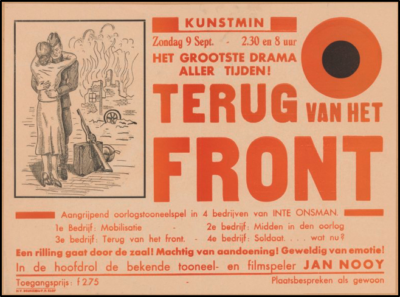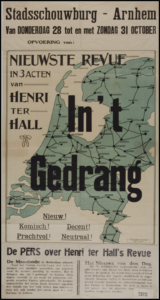War plays in the Netherlands 1914-1918 by Dr. Ad van der Logt

Did you know that more than 40 war plays were written or performed in the Netherlands during the Great War? That’s an average of 8 each year!
The first reactions
Already in August 1914 the famous Dutch socialist playwright Herman Heijermans (1864-1924) wrote three sketches: Brief in den schemer (Letter in twilight), De buikspreker (The ventriloquist) and Herenhuis te koop (Mansion for sale), which were performed the same month in the Grand Théâtre in Amsterdam. In the last two grotesques there are numerous references to the actuality of the first August weeks.Brief in schemer is dramatically the most interesting piece. A blind widow asks her neighbor, the school master of the village, to write a letter to her mobilized son. The old woman doesn’t understand why soldiers shoot at each other while they don’t see the enemy. She thinks of all those thousands of mothers who all ask the same questions: ‘Why, for what, dear Lord? … ‘. Esther de Boer-van Rijk (1853-1937) and Jan Musch (1875-1960) played Letter in twilight more than 150 times between August 1914 and January 1915. Two weeks later Nelly Hoekstra-Kapteijn (1865-1919) wrote De spion (The spy), a romantic comedy in one act with no spy and a happy end. This play only shows the consternation in times of mobilization.
Poor little Belgium
The German assault on Belgium we can follow in Vluchtelingen (Refugees, 1915) and Pastor Bonus (The Good Shepperd, 1918), both written by Henri ‘t Sas (1877-1966), and in De dochter van den franc-tireur (The franc tireur’s daughter, 1918) by Dirk Janse (1875-1962).
In Pastor Bonus the siege of Antwerp is symbolized in the battle of blacksmith Van Neste to rescue his forge against the acquisition by a large metal company led by the German Carl Laube. This acquisition takes the form of a metaphor: the small Belgian smithy is a symbol of poor little Belgium, which shall be destroyed by the much larger neighbor in August 1914.
In 1918 and 1919 Dirk Janse traveled with his company along Dutch theatres and village social centers. The franc tireur’s daughter achieved more than 500 performances, which could indicate the need of the Dutch public to take personal notice of the horrors of our southern neighbors. In the first act, an angry inhabitant of Visé is shooting on the German troops. He is captured and immediately executed as franc tireur, as so many residents of that little town on the Meuse riverside. In ‘The way to Brussels’, the dramatic action moves westwards and in the third act ‘Back to the front’, a mother finds her son, a soldier in the Belgian army, fallen on the battlefield. The fourth act is playing in a Ghent hospital, where a Red Cross nurse cares for many wounded soldiers, but she finds death in an enemy air attack. The piece ends with ‘A Christmas night at the Yser’ about the Christmas Truce.
Anti-war plays of Belgian refugees
Among the Belgian refugees there were a number of playwrights who wanted to take action against the German assault on Belgium, combining the horrors of the war with a necessary dose of patriotism. Abraham Hans (1882-1939) remodeled his novels and played them with a group of Belgian refugees in the province of Sealand. His most known play is Moeder der soldaten (Mother of the soldiers, 1916) which was performed seven times, especially on or around the birthday of Queen Elisabeth of Belgium, the wife of King Albert I. On February 8, 1917, the Vlissingse Courant reported that this play will be performed in this same month in Richmond and London. I will give you more information about Abraham Hans in another blog. During his internment Henri van Daele (1877-1957) wrote In Holland geïnterneerd (In Holland interned, 1915). Because he wouldn’t endanger Dutch neutrality, he provided his play Oorlogskinderen (War Children, 1915) with the subtitle ‘realistic play far away’ to hide direct references to the German invasion in Belgium. August Monet (1875-1958) wrote with Het vuur dat loutert (The fire that chastens, 1918) a most nationalistic play about the battle of the Marne in August and the first half of September 1914. It combines the Lenoir and Bolo Pacha-affaires of 1917 with the role of our most famous spy during World War I: Mata Hari (Margaretha Zelle, 1876-1917).
Revues
 Henriter Hall, already before the Great War in Holland known as ‘the king of the revue’ produced three revues in wartime. Critics of provincial newspapers praised the comic situations in the performances and how they were staged. They were also impressed how actuality was present in these performances. On September 22, 1915, a journalist wrote about the revue In ‘t gedrang (In the crowd): ‘How mercilessly the tableau ‘Peace’ is with its mature cornfields between smiling villages. And what a bitter contrast does this make with the following tableau ‘War’, where the fertile lands were destroyed and the farmers had to take place for the soldiers, with a burning village in the background.’ In the subsequent scenes of this revue, the rivers Rhine, Seine, Danube, Thames, Maas and Neva were shown in peacetime. After each of these scenes followed a thundering applause.Ter Hall was not the only one. Corporal Hero Bleeker wrote in the same year the allegorical revue Holland blijft neutraal (Holland stays neutral, 1915). In the performance of the military theatre ensemble of Fort Spijkerboor, the central part of the revue is the confrontation of the war god Mars and the angel of peace, which is interspersed with events from the life of soldier Kees Knut.
Henriter Hall, already before the Great War in Holland known as ‘the king of the revue’ produced three revues in wartime. Critics of provincial newspapers praised the comic situations in the performances and how they were staged. They were also impressed how actuality was present in these performances. On September 22, 1915, a journalist wrote about the revue In ‘t gedrang (In the crowd): ‘How mercilessly the tableau ‘Peace’ is with its mature cornfields between smiling villages. And what a bitter contrast does this make with the following tableau ‘War’, where the fertile lands were destroyed and the farmers had to take place for the soldiers, with a burning village in the background.’ In the subsequent scenes of this revue, the rivers Rhine, Seine, Danube, Thames, Maas and Neva were shown in peacetime. After each of these scenes followed a thundering applause.Ter Hall was not the only one. Corporal Hero Bleeker wrote in the same year the allegorical revue Holland blijft neutraal (Holland stays neutral, 1915). In the performance of the military theatre ensemble of Fort Spijkerboor, the central part of the revue is the confrontation of the war god Mars and the angel of peace, which is interspersed with events from the life of soldier Kees Knut.
Holland’s most famous war play
With Het licht in den nacht (Light into Darkness, 1918) – also released under the title Terug van het front (Back from the Front) – about the home front in Germany, author Inte Onsman (1872-1929) wants to make clear to the Dutch public that the Germans are equally victims of the war. Onsman’s play has two main themes: the horrors of the war and the emerging socialist society after the war. The first theme is symbolized by Heinrich Balke, the son of blind basket maker Peter Balke, a veteran from 1870-71. If he needs to get up for his number, he leaves to the front and returns badly injured. A grenade causes the lost the light in his eyes.
Peter’s second son Frits is the symbolization of the second theme. On the market he has read the announcement of the mobilization. When he reports at home of the war enthusiasm of the villagers, the differences of opinion are high. Frits tirade contains three important aspects. Diplomats and generals are responsible for the outbreak of war. They run on the leash of capitalism and try to make a career. Secondly, he argues that Germany has a small market for its industrial products in comparison with England, an economic factor that has actually played a major role. Finally, he believes that Germany more can focus on a future in which socialism will prevail.
Why did he choose a German family? Onsman stated that he didn’t want to follow the partial conversations and condemnations of the mass. And being he socialist, he knew such families as the Balke’s lived in Germany. His play was performed more than 2000 times during the war and the interbellum by different groups.
To find out more contact Dr. Ad van der Logt at ad@vdlogt.demon.nl
